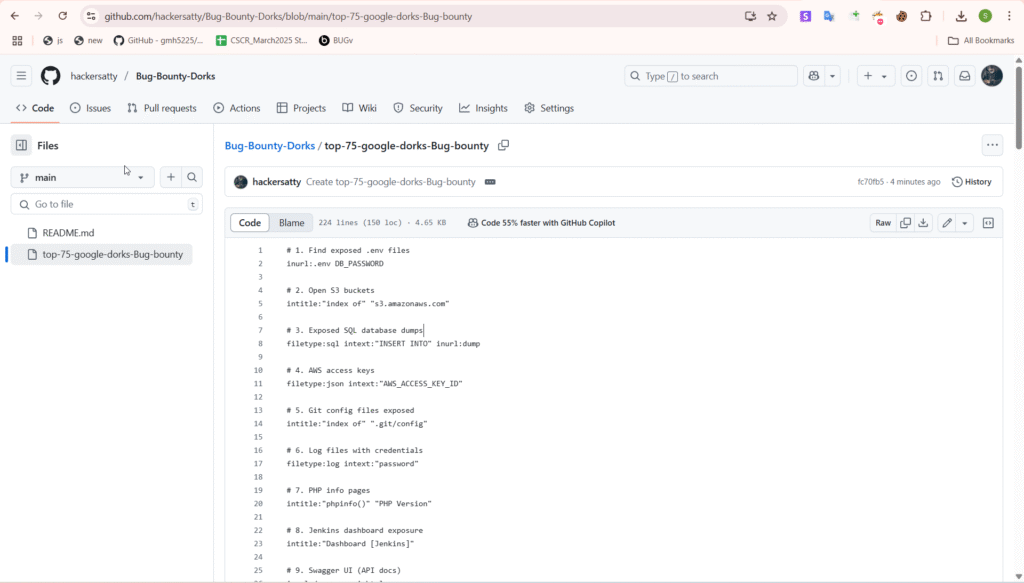25+ Google Dorks for Bug Bounty: Find Exposed Signatures, NDAs & Confidential Docs
By Satyam Pawale (@hackersatty)
About Me
Google Dorks Bug bounty is one of the most underrated skills in bug bounty hunting, yet it can lead to discovering high-severity and real-world vulnerabilities. I’m Satyam Pawale, widely known in the cybersecurity community as @hackersatty. As a passionate bug bounty hunter, I specialize in uncovering impactful bugs through creative reconnaissance techniques, especially using publicly available search engines like Google.
In this article, I’ll show you how to perform actionable bug bounty reconnaissance using Google Dorks Bug bounty to discover sensitive information like signature pages, NDAs, internal contracts, credentials, and other confidential files that are often unintentionally exposed on the web. Whether you’re a beginner or a seasoned hunter, you’ll learn how to add this powerful skill to your recon arsenal.
Let’s dive deep into the art of dorking for vulnerabilities.
Introduction
Google Dorking, also known as Google hacking, is an advanced search technique used to find exposed sensitive information through the use of tailored Google queries. For bug bounty hunters, Google Dorks Bug Bounty can serve as a gateway to discovering misconfigurations, exposed credentials, hidden portals, and even full documents that were never meant to be public.
I’m Satyam Pawale, widely known in the cybersecurity community as @hackersatty. As a passionate bug bounty hunter, I specialize in unearthing hidden vulnerabilities and valuable assets using methods that are both manual and automation-driven. Google Dorking is one of the oldest yet still highly effective methods for performing reconnaissance during bug bounty assessments.
In this article, we’ll walk through real-world examples, advanced Google Dork techniques, signature hunting, and tips to optimize your bug bounty recon. Whether you’re just starting out or already deep into bug bounty hunting, this guide will give you a fresh edge using Google search itself.
What is Google Dorking?
Google Dorking involves using special search operators to extract hidden information from public-facing websites. The idea is that Google indexes everything—sometimes more than it should—and by crafting specific queries, you can find pages that developers never intended to be indexed.
Focus Keyword: Google Dorks Bug Bounty
Why Use Google Dorks Bug Bounty?
Bug bounty is about scope, precision, and creativity. Often, the most critical bugs are buried in obscure or forgotten assets. Google Dorks Bug Bounty let you:
- Find sensitive documents (PDF, XLSX, DOCX, TXT)
- Uncover exposed login panels and admin consoles
- Locate API keys or credentials in indexed pages
- Discover configuration files or server info
- Reveal staging environments and forgotten subdomains
Google Dorks extend your recon capabilities without the need for intrusive scanning.
Real-World Examples of Google Dorks Bug Bounty
1. Finding Exposed PDF Contracts
site:example.com filetype:pdf confidentialUse this to find PDF files with potentially sensitive contracts or agreements. Add intitle:"nda" to refine for NDAs.
site:example.com filetype:pdf intitle:nda2. Discovering Passwords in GitHub Repos
site:github.com "api_key" "example.com"Search GitHub for exposed API keys linked to your target.
3. Login Panel Discovery
site:example.com inurl:adminsite:example.com intitle:"login"Great for finding potential login endpoints and bypassing public-facing dashboards.
4. Configuration Files Exposure
site:example.com ext:env | ext:yaml | ext:jsonMany .env, .yaml, or .json files contain DB credentials and API tokens.
5. Index Pages and Directory Listings
site:example.com intitle:"index of /"Use this to locate open directories or file servers.
Dork Crafting Approach
A smart bug bounty hunter understands how to craft dorks per asset type. Here’s how to approach it:
Step 1: Understand the Asset Type
- Web apps: Look for login pages, dashboards
- APIs: Look for documentation, keys, usage logs
- Documents: PDFs, Excel sheets, TXT notes
- Cloud Storage: Google Drive, AWS S3, Firebase
Step 2: Combine Keywords & Operators
Use logical operators:
site:to limit to a domainfiletype:to find specific formatsintitle:for keyword in titleinurl:for keyword in URLcache:to view old or deleted versions
Step 3: Add Contextual Terms
Terms like “confidential”, “internal use only”, “do not share”, “restricted” often lead to gold mines.
site:example.com filetype:pdf "internal use only"Advanced Signature Hunting Using Google Dorks
A powerful tactic is finding signature pages that contain document footers, author names, company templates, or timestamp structures. You can do this by:
Searching for Signature Markers
site:example.com filetype:pdf "Signature"site:example.com filetype:pdf "Authorized Signatory"These can reveal:
- Contractual documents
- Signed NDAs
- Employment documents
- Partnership forms
Sometimes these documents contain personal info, email IDs, full addresses, or contract clauses—providing strong reconnaissance material or even PII disclosures.
Example:
site:gov.in filetype:pdf "Signature"Results may include tender documents with authorizing signatories and sensitive contact information.
Hunting Exposed IP Addresses
You can look for IP addresses by searching for headers or configuration exposures:
site:example.com intext:"X-Forwarded-For:"site:example.com intext:"Server IP"These dorks help you track misconfigured headers or identify internal infrastructure.

Practical Use in Bug Bounty Programs
Here’s how to leverage these discoveries:
Recon Stage
- Use Google Dorks to discover undocumented subdomains and portals.
- Validate sensitive file exposure.
Exploitation Stage
- Analyze PDF/Excel documents for hardcoded credentials or PII.
- Use configuration files to attempt login or privilege escalation.
Reporting Stage
- Provide the full Dork used.
- Include metadata (e.g., PDF timestamp, author info).
- Explain potential impact (e.g., credential reuse, data leakage).
Tips to Avoid False Positives
- Validate URLs using tools like
curl,wget, orBurp Suite. - Use Google Cache to grab deleted or moved files.
- Be cautious of decoy pages or honeypots.
Tools to Combine With Google Dorks
- GitHub Dorking Tools: Use
github-dorkto automate GitHub leak discovery. - GoogleHackingDatabase: Explore pre-built dorks from Exploit-DB.
- DorkScanner: Automates mass scanning with custom dorks.
- Burp Suite: Validate endpoints or files.
Final Thoughts : Other Bug Bounty Blogs
Google Dorking remains a powerful reconnaissance technique in modern bug bounty methodology. With the right mindset and crafted queries, it’s possible to uncover sensitive files, misconfigurations, credentials, and more—without sending a single request to the server. This makes it especially useful for stealthy or scope-sensitive bug bounty programs.
Remember: always stay within scope, validate what you find, and follow responsible disclosure guidelines.
Keep exploring. Keep hunting.
